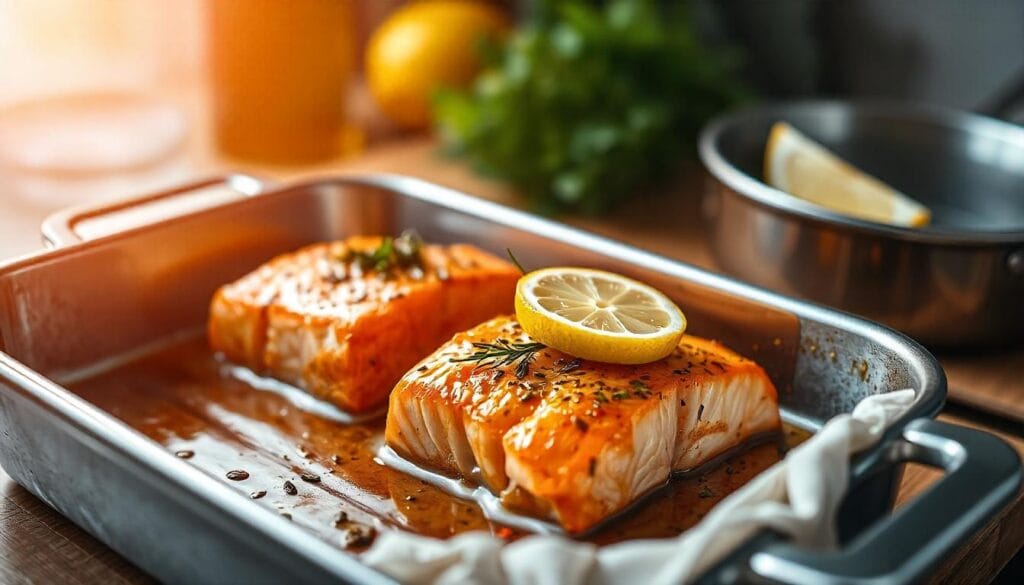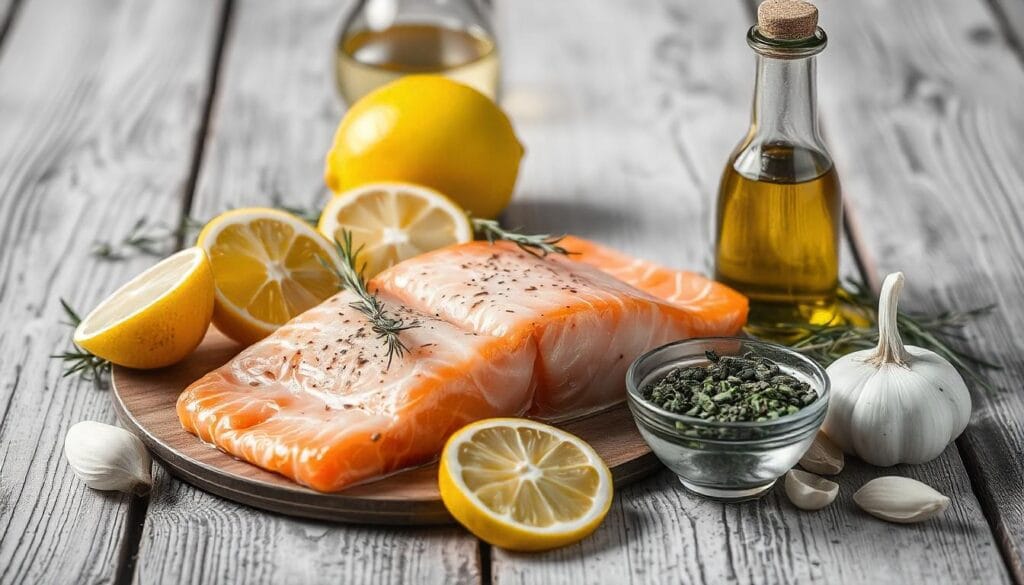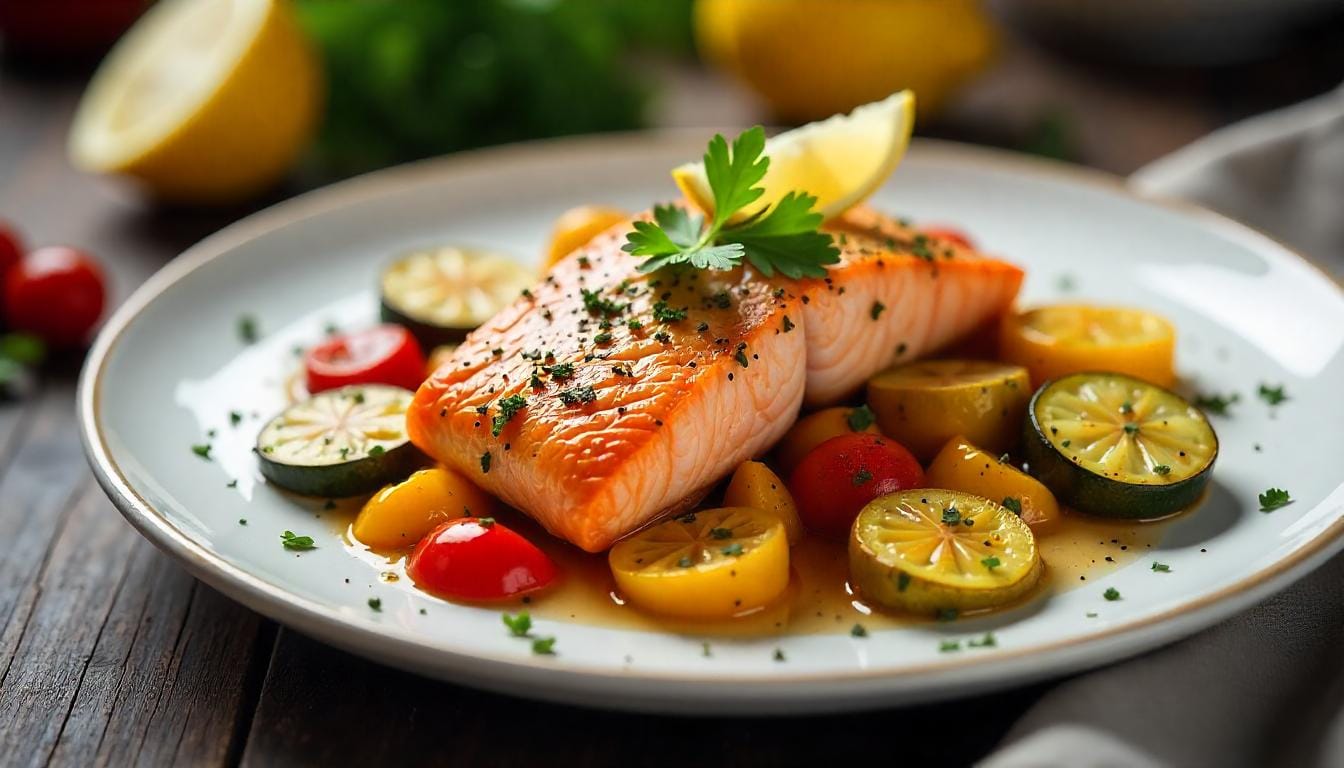Salmon is like the superhero of the seafood world—packed with nutrients, versatile, and downright delicious. But when you combine it with the vibrant flavors of the Mediterranean, it becomes something truly magical.Whether you’re a seasoned chef or a kitchen newbie, this guide will walk you through everything you need to know to create a mouthwatering Mediterranean Salmon Recipe that’ll impress your family, friends, and even yourself!
Table of contents
- Why Mediterranean Salmon is a Must-Try Dish
- Essential Ingredients for a Mediterranean Salmon Recipe
- Step-by-Step Guide to Making Mediterranean Salmon
- Common Problems and Solutions When Cooking Mediterranean Salmon
- Pairing Mediterranean Salmon with Sides and Drinks
- Variations, Storage Tips, and FAQs for Mediterranean Salmon
Why Mediterranean Salmon is a Must-Try Dish
Let’s be real: salmon is already a crowd-pleaser. But when you infuse it with the fresh, zesty, and aromatic flavors of the Mediterranean, it’s like taking your taste buds on a vacation to the sunny coasts of Greece or Italy. This Mediterranean Salmon Recipe is not just a meal—it’s an experience.
The Health Benefits of Mediterranean Salmon
First off, let’s talk about why this dish is a win for your health. Salmon is loaded with omega-3 fatty acids, which are like the VIPs of heart health. They help reduce inflammation, improve brain function, and even boost your mood. Combine that with the Mediterranean diet’s emphasis on fresh vegetables, olive oil, and herbs, and you’ve got a meal that’s as good for your body as it is for your soul.
“The Mediterranean diet isn’t just a way of eating—it’s a way of living. It’s about savoring fresh, wholesome ingredients and enjoying meals with loved ones.”
Why Salmon is a Staple in Mediterranean Cuisine
Salmon might not be native to the Mediterranean Sea, but it’s become a beloved ingredient in the region’s cuisine. Why? Because it’s incredibly versatile and pairs perfectly with the bold flavors of Mediterranean cooking. Think lemon, garlic, oregano, and olive oil—ingredients that make salmon sing.
Essential Ingredients for a Mediterranean Salmon Recipe
Before we dive into the cooking process, let’s talk about the star players in this Mediterranean:
| Ingredient | Quantity | Why It’s Important |
|---|---|---|
| Fresh salmon fillets | 4 (6 oz each) | The star of the dish! |
| Extra virgin olive oil | 3 tbsp | Adds richness and healthy fats. |
| Lemon juice | 2 tbsp | Brings a zesty, fresh flavor. |
| Garlic cloves | 3 (minced) | Adds depth and aroma. |
| Dried oregano | 1 tsp | A classic Mediterranean herb. |
| Paprika | 1 tsp | Adds a hint of smokiness. |
| Salt and pepper | To taste | Enhances all the flavors. |
| Fresh parsley | For garnish | Adds a pop of color and freshness. |
Fresh vs. Frozen Salmon: Which is Better?
If you’re wondering whether to use fresh or frozen salmon, here’s the deal: both can work! Fresh salmon is ideal if you can get your hands on it, but high-quality frozen salmon is a great alternative. Just make sure to thaw it properly in the fridge overnight.
Key Herbs and Spices in Mediterranean Cooking
Mediterranean cuisine is all about simplicity and letting the natural flavors shine. Herbs like oregano, thyme, and rosemary are staples, while spices like paprika and cumin add warmth and depth. Don’t forget the garlic—it’s the unsung hero of Mediterranean cooking!
The Role of Olive Oil in Mediterranean Salmon Recipes
Olive oil isn’t just a cooking ingredient; it’s a way of life in the Mediterranean. It adds richness, helps the herbs and spices stick to the salmon, and gives the dish a luxurious finish. Plus, it’s packed with heart-healthy monounsaturated fats.
Step-by-Step Guide to Making Mediterranean Salmon

Now that we’ve got our ingredients ready, let’s get cooking! Follow these steps to create a Mediterranean Salmon Recipe that’ll have everyone asking for seconds
Preparing the Salmon: Tips for Perfect Fillets
Start by patting your salmon fillets dry with a paper towel. This helps the seasoning stick and ensures a nice, crispy exterior. If you notice any pin bones, use tweezers to remove them—it’s a small step that makes a big difference.
Marinating Techniques for Maximum Flavor
In a small bowl, whisk together the olive oil, lemon juice, minced garlic, oregano, paprika, salt, and pepper. Place the salmon fillets in a shallow dish and pour the marinade over them, making sure they’re evenly coated. Let them marinate for at least 30 minutes (or up to 2 hours) in the fridge.
“Marinating is like giving your salmon a flavor bath. The longer it soaks, the more delicious it becomes!”
Cooking Methods: Baking, Grilling, and Pan-Searing
Here’s where you can get creative. Each cooking method brings out a different side of the salmon:
- Baking: Preheat your oven to 375°F (190°C). Place the salmon on a baking sheet lined with parchment paper and bake for 12-15 minutes, or until it flakes easily with a fork.
- Grilling: Heat your grill to medium-high. Place the salmon skin-side down and grill for 4-5 minutes per side, until it’s slightly charred and cooked through.
- Pan-Searing: Heat a tablespoon of olive oil in a skillet over medium-high heat. Place the salmon skin-side up and cook for 3-4 minutes per side, until golden and crispy.
Common Problems and Solutions When Cooking Mediterranean Salmon
Even the best chefs run into issues sometimes. Here’s how to troubleshoot common problems when preparing your Mediterranean Salmon Recipe:
Problem: Salmon Sticks to the Pan
Solution: Make sure your pan is hot before adding the salmon, and don’t move it around too much. A well-seasoned cast-iron skillet or non-stick pan works wonders.
Problem: Overcooked or Dry Salmon
Solution: Keep an eye on the internal temperature—salmon is done when it reaches 145°F (63°C). Remember, it’ll continue cooking a bit after you take it off the heat.
Problem: Lack of Flavor
Solution: Don’t skimp on the marinade! Let the salmon soak up all those delicious flavors, and don’t forget to season generously with salt and pepper.
Pairing Mediterranean Salmon with Sides and Drinks

No Mediterranean Salmon Recipe is complete without the perfect sides and drinks. Here are some ideas to elevate your meal:
Best Side Dishes to Complement Mediterranean Salmon
- A fresh Greek salad with tomatoes, cucumbers, and feta cheese.
- Roasted vegetables like zucchini, bell peppers, and eggplant.
- A bowl of fluffy couscous or quinoa.
Wine and Beverage Pairings for Mediterranean Salmon
- A crisp white wine like Sauvignon Blanc or Pinot Grigio.
- A refreshing glass of iced tea with a slice of lemon.
- Sparkling water with a splash of pomegranate juice.
Variations, Storage Tips, and FAQs for Mediterranean Salmon
Welcome back to our Mediterranean salmon adventure! In Part 1, we covered the basics—why this dish is a must-try, the essential ingredients, and a step-by-step guide to cooking it perfectly. Now, let’s take things up a notch with creative recipe variations, tips for storing and reheating leftovers, and answers to some frequently asked questions.
Variations of the Mediterranean Salmon Recipe
One of the best things about Mediterranean salmon is how versatile it is. You can tweak the flavors to suit your mood or what’s in your pantry. Here are three delicious variations to try:
Mediterranean Salmon with Lemon and Herbs
This is the classic version we covered earlier, but let’s make it even more vibrant. Add a handful of chopped fresh herbs like dill, parsley, and basil to the marinade. The result? A bright, herbaceous dish that’s perfect for spring or summer.
“Herbs are like the confetti of the culinary world—they add color, flavor, and a touch of celebration to any dish.”
Spicy Mediterranean Salmon with Harissa
If you’re a fan of heat, this variation is for you. Harissa, a North African chili paste, adds a smoky, spicy kick to the salmon. Mix 1-2 tablespoons of harissa into the marinade, and adjust the amount based on your spice tolerance. Serve with a cooling yogurt sauce to balance the heat.
Mediterranean Salmon Salad: A Light and Healthy Option
Turn your salmon into a refreshing salad! Flake the cooked salmon into bite-sized pieces and toss it with mixed greens, cherry tomatoes, cucumbers, red onions, and a simple lemon-olive oil vinaigrette. Top with crumbled feta cheese and olives for an extra Mediterranean flair.
Storing and Reheating Mediterranean Salmon
Let’s face it: sometimes you end up with leftovers. But don’t worry—Mediterranean salmon tastes just as good the next day if you store and reheat it properly.
How to Store Leftover Mediterranean Salmon
Place the cooled salmon in an airtight container and store it in the fridge for up to 2 days. If you want to keep it longer, you can freeze it for up to 2 months. Just wrap it tightly in plastic wrap or aluminum foil before placing it in a freezer-safe bag.
Best Practices for Reheating Salmon Without Drying It Out
Reheating salmon can be tricky because it’s easy to overcook. Here’s how to do it right:
- Oven Method: Preheat your oven to 275°F (135°C). Place the salmon on a baking sheet, cover it with foil, and heat for about 15 minutes, or until warmed through.
- Stovetop Method: Heat a skillet over low heat. Add a splash of olive oil or water, place the salmon in the pan, and cover it with a lid. Heat for 5-7 minutes, flipping halfway through.
- Microwave Method: Place the salmon on a microwave-safe plate, cover it with a damp paper towel, and heat on low power in 30-second intervals until warmed through.
Frequently Asked Questions About Mediterranean Salmon Recipes
Got questions? We’ve got answers! Here are some common queries about Mediterranean salmon:
Can I Use Other Fish Instead of Salmon?
Absolutely! While salmon is the star of this recipe, you can use other fatty fish like trout, mackerel, or even cod. Just adjust the cooking time based on the thickness of the fillets.
How Long Should I Marinate the Salmon?
For the best flavor, marinate the salmon for at least 30 minutes. If you’re short on time, even 15 minutes will do. But if you’re planning ahead, you can marinate it for up to 2 hours. Just don’t go longer than that, as the acid in the lemon juice can start to “cook” the fish.
Is Mediterranean Salmon Suitable for a Keto Diet?
Yes! Mediterranean salmon is naturally low in carbs and high in healthy fats, making it a great option for a keto diet. Just pair it with low-carb sides like roasted vegetables or a fresh salad.
Nutrition Facts of Mediterranean Salmon
Here’s a breakdown of the nutritional value of a typical serving of Mediterranean salmon:
| Nutrient | Amount per Serving (6 oz fillet) |
|---|---|
| Calories | 367 |
| Protein | 34 g |
| Fat | 23 g |
| Saturated Fat | 4 g |
| Carbohydrates | 2 g |
| Fiber | 0 g |
| Sugar | 0 g |
| Sodium | 420 mg |
As you can see, this dish is not only delicious but also packed with protein and healthy fats. It’s a win-win for your taste buds and your body!
Conclusion: Mastering the Mediterranean Salmon Recipe
By now, you’re practically a Mediterranean salmon pro! You’ve learned why this dish is so special, how to prepare it with confidence, and even how to switch things up with creative variations. Whether you’re cooking for a special occasion or just a weeknight dinner, this recipe is sure to impress.
Recap of Key Tips and Techniques
- Use fresh, high-quality ingredients for the best flavor.
- Don’t skip the marinade—it’s the secret to a flavorful dish.
- Experiment with different cooking methods to find your favorite.
- Store and reheat leftovers carefully to avoid drying out the salmon.
Encouragement to Experiment and Enjoy
Cooking is all about having fun and making the recipe your own. So don’t be afraid to get creative! Add your favorite herbs, try a new spice, or pair the salmon with a side dish you’ve never tried before. The possibilities are endless.
And there you have it—the ultimate guide to mastering the Mediterranean salmon recipe. Whether you’re a seasoned chef or a kitchen newbie, this dish is sure to become a staple in your recipe collection. So grab your apron, fire up the stove, and let’s get cooking!
Bon appétit!

